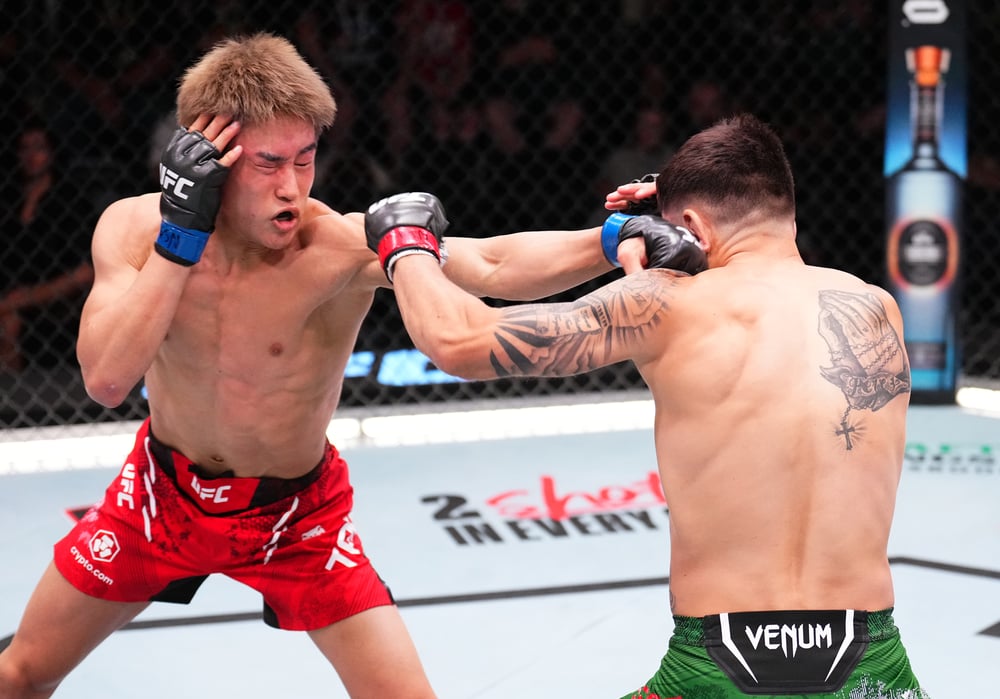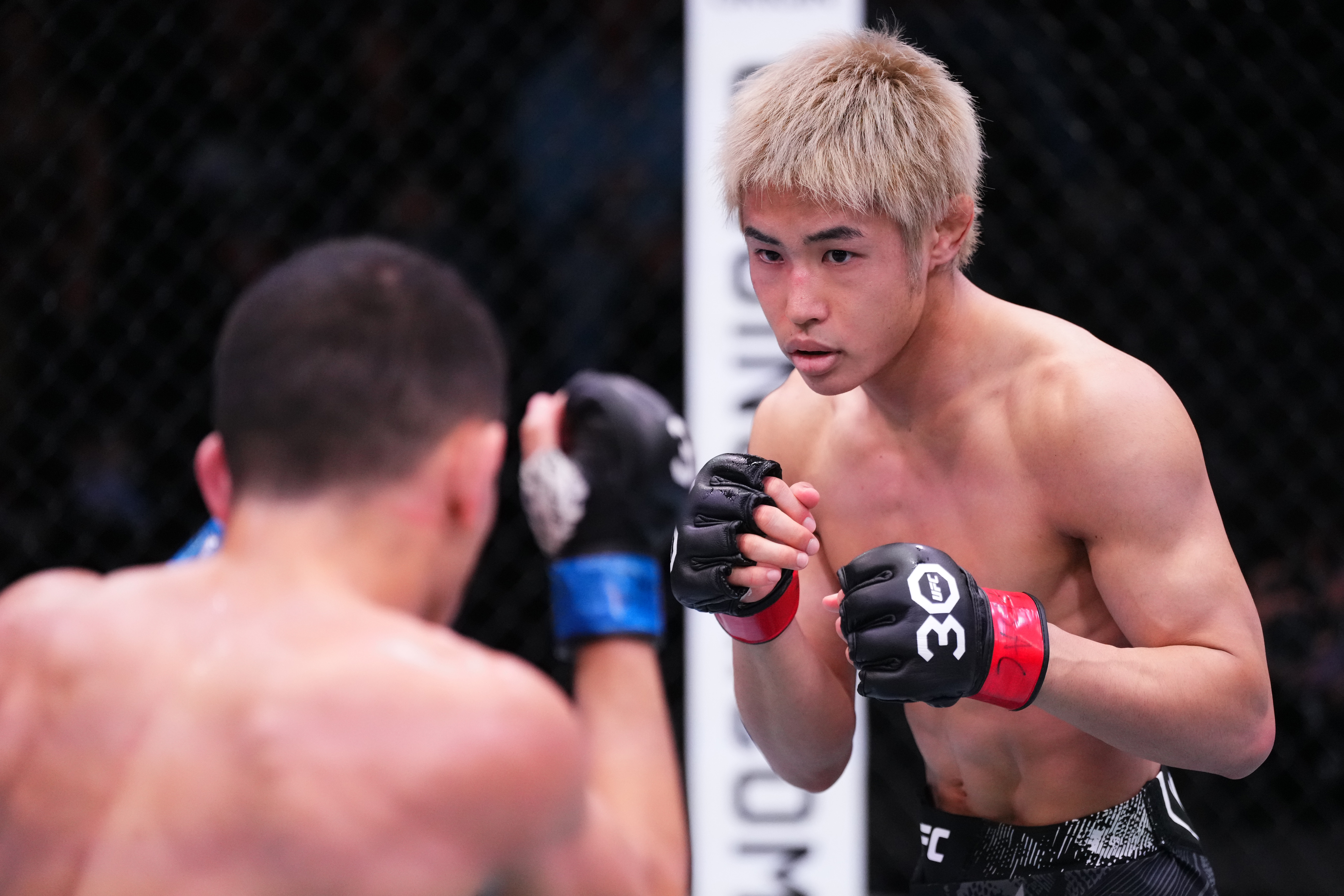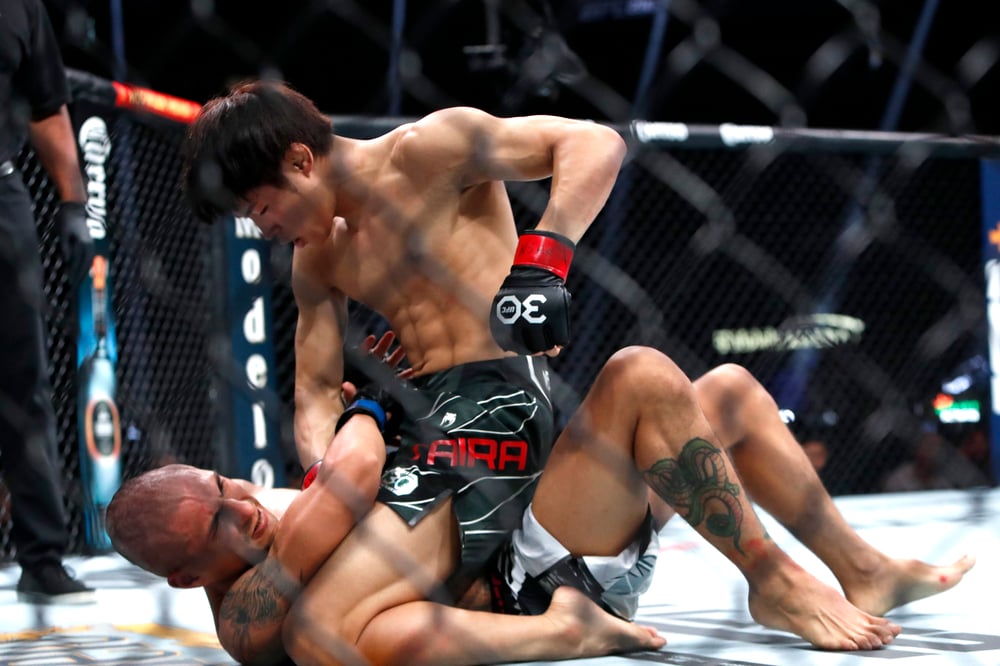
Issue 209
September 2024
Kyle Dimond explores how Tatsuro Taira, Japan’s rising MMA sensation, is poised to revitalize the sport's legacy in a country that once thrived on martial arts as he targets a shot at the UFC flyweight title.
Before it had taken off in the United States, MMA first found its footing in Japan. Though the ‘Land of the Rising Sun’ is integral to the sport's history, the Octagon has remained a stranger to Japan for the last seven years. Even when the UFC was trying to become a regular visitor, there was little to inspire fans about the future of Japanese MMA. That was until 22-year-old Tatsuro Taira signed with the UFC. Boasting an undefeated record of 6-0 inside the Octagon, Taira is preparing to headline his second event at the UFC Apex. As the #5 in the flyweight division meets #1, this rising star looks to take out a serious contender, former title challenger Brandon Royval to earn a shot at the 125-pound gold.

SETTING A HIGH BAR
The UFC’s debut in Japan came in a massive year for the sport. In 1997, UFC Ultimate Japan featured several icons from the sport's early days. Tank Abbott, Kazushi Sakuraba, Frank Shamrock, Vitor Belfort, and Randy Couture were all on show. Over the next several years, the promotion would return to capitalize on the sport's popularity in Japan, largely thanks to Pride, with UFC 23, 25, and 29 all taking place before 2000 ended. Aside from the notable fighters who competed at these events, the most significant element about this series is what would happen after UFC 29 on December 16. It would mark the final event in this first chapter of the promotion. Semaphore Entertainment Group (SEG) would sell the UFC to Zuffa LLC the following month, handing it over to Dana White and the Fertitta brothers. After the promotion fell under new ownership, it would be another 11 years until the UFC returned to what was previously a regular stop.
THE FALL OF BOTH PRIDE AND INTEREST
The collapse of Pride had a considerable impact on Japan’s MMA scene. Despite its success, its reputation took a hit following reports it was connected with organized crime. Eventually, its partners, who helped position it as a major player in Japanese entertainment, withdrew. Even the UFC buying out the promotion in March 2007 wasn’t enough to salvage it. It had captured the hearts and minds of its fans only to pull the sport down with it. Not to mention that, at the time, the UFC was heading in the opposite direction to the no-holds-barred spectacle that had initially been Pride’s identity. As the UFC’s Senior Vice President and Head of Asia, Kevin Chang has played a considerable part in attempting to rebuild the UFC’s relationship with the Japanese fans who lost interest in MMA once Pride disappeared. In an interview with The Japan Times last year, Chang spoke about how the fallout is still felt today.
“Everything suffered about the sport itself - the talent base, the number of competitions that were going on, and the overall interest level,” Chang said in a piece by Dan Orlowitz. “So that's really what we've been working on over the past decade or so. We've seen this uptick over the years (with MMA) getting back into becoming a sport that's respected (in Japan).”
That’s not to say that the UFC hasn’t attempted to regain a foothold in one of its former homes. From 2012 to 2017, with 2016 excluded, the promotion hosted an annual event at the iconic Saitama Super Arena. The following four would be standard Fight Night cards featuring athletes who had previously competed or made their names in Japan through Pride or K-1 (Wanderlei Silva, Mark Hunt, etc.). However, the promotion’s return saw them equipped with a numbered PPV event. UFC 144 featured Benson Henderson defending his lightweight title against Frankie Edgar in the main event. Quinton ‘Rampage’ Jackson, Mark Hunt, and Jake Shields brought additional firepower, along with Japanese fighters like Yoshihiro Akiyama and Yushin Okami. Despite getting the big guns overseas, the UFC was effectively starting from scratch.
This run of semi-regular events ended in 2017, totaling nine trips to Japan for the promotion. In a video posted by MMA Fighting during fight week for UFC 144, Ariel Helwani walked around Japan to find MMA fans. He asked them why the sport was no longer as big in their country, and they accurately summarized the key issues.
“Maybe because of all the Yakuza problems. Also, a lack of broadcasting has caused a big decline. If they get better broadcasting, maybe it can return to where it used to be.”
“Maybe it’s because most of the famous fighters go to the States and leave Japan.”
“If there is a big event, we will watch, love, and talk about it. If there is no event, people just don’t care about it.”

REBUILDING THESE BRIDGES
Following the collapse of Pride, the fans lost interest because there wasn’t enough exposure on TV and with live events, and no new stars were being built in that region. That’s not to say that Japanese athletes didn’t achieve success in MMA. They did, but a lot of it happened in the United States. Though Dream looked to be a new version of Pride, launching in 2008, it would only be around for four years. In the meantime, several other Asia-focused promotions started to grow, with Rizin and ONE Championship becoming more significant.
The former president of Pride, Nobuyuki Sakakibara, returned to MMA by launching Rizin in 2015 following a seven-year non-compete clause that came with the sale of Pride to Zuffa LLC in 2007. There are both similarities and differences between Pride and the promotion that would be its spiritual successor. Speaking to Fighters Only, Andrew Benjamin, who hosts the We Are Rizin Podcast, talked about how Sakakibara’s promotion brought the Japanese fans back on board.
“I think MMA was always ever present [in Japan],” he says. “Pancrase, Shooto, UFC Japan show, Deep, and others got to fill that void. Pancrase was probably number one by default in terms of attendance, and that it was a direct pipeline to UFC at one point. What Rizin showed, though, was that MMA was a sport that could draw fans in bigger arenas and be a television property, initially being on Fuji TV.”
Benjamin argues that the UFC would struggle to sell itself as an international product in Japan without having stars it could rely on in this region.
“Talent pool is definitely a factor,” says Benjamin. “Very few Japanese fighters, in my personal opinion, were UFC level. And we got to see that with the results of their fights. A lot got finished in their losses or got dominated in decisions. But there are other factors, too. Some managers from Japan are notoriously very difficult to deal with. There’s also a way of conducting business differently. Taira is signed with Iridium, for example. There have been cases where managers will accept a fight for their client without even consulting them.”
In his interview with The Japan Times, Kevin Chang echoed this, stating that the UFC’s previous pathways for Japanese fighters weren’t sufficient.
“We sat back, and we took the top talent that we could find out here,” he said. “We took these guys in, the champions of these smaller domestic original promotions, and put them in the UFC, and they didn't do well.”
The talent in Japan needed more development before signing up for the UFC, but this wouldn’t be an option if they ended up joining another promotion.
“Now we're seeing that the talent is certainly rising, as evidenced by the number of local promotions here, whether that's Pancrase, Deep, or Shooto,” Chang said. “Those are three big names that have kind of come back up and are producing good fighters from this region, giving them opportunities. We need that ecosystem because we sit at the top as the world's premier MMA organization. We recruit the best fighters from every country. And so, we need that ecosystem to kind of provide that level of talent coming into the UFC.”
What changed was the promotion’s attempt to build and utilize relationships with some of the smaller promotions in Japan. As Chang describes it, building that ecosystem allows them to create opportunities for fighters to gather experience and prove themselves before making the big step up to the UFC, and that’s where the tide of change has taken place, as evidenced by Tatsuro Taira’s run in the promotion.
THE FACE OF THE NEW ERA
Tatsuro Taira is proof of how that structure being put in place will massively benefit the UFC’s standing in Japan and the fighters from this region. Not only do they now have a major streaming platform in U-Next, which is the home of the UFC for Japanese fans, but the MMA leader can best prepare potential talent for competing at the highest level. With most of his experience coming in Japanese promotion Shooto, Taira has adapted seamlessly to life inside the Octagon and, at just 24 years old, is on the cusp of a title shot.
Many Japanese fighters have competed for UFC titles in the past. Unfortunately, in most instances, they came up against some of the all-time greats in their weight classes. From Yushin Okami challenging Anderson Silva to Kyoji Horiguchi facing Demetrious Johnson to Caol Uno and Hayato Sakurai clashing with BJ Penn and Matt Hughes. Taira is likely just one win away from getting his opportunity to make history.
Taira isn’t the only symbol of how the UFC’s greater focus on Japan has already started to pay off. In 2022, the UFC launched a new way of filtering the best talent into their roster. Road to UFC pits the top Asian prospects against one another in a tournament-style format. Through two completed seasons, three Japanese fighters have been signed to the promotion. The final stage of the third season will take place at the UFC Fight Night event hosted in Macau, China, on November 23rd.
After being a runner-up in the first series, 27-year-old Toshiomi Kazama earned his first win in the UFC in August. However, the two Japanese fighters who have won their tournaments are making some noise inside the Octagon. Rinya Nakamura, who stopped Kazama in 2023, has won back-to-back fights in the bantamweight division. The 22-year-old Rei Tsuruya put on a stylish performance on a big stage at UFC 303 to earn his debut win.

BIG NAMES, BIG THINGS
Along with Taira, Nakamura, and Tsuruya, who could all become potential headliners in Japan, earlier this year, the UFC signed a fighter already built to do just that. It has been a long time since the promotion acquired a big name from a different organization, and though he hasn’t debuted yet, that’s what they’ve got with Kai Asakura.
The former Rizin bantamweight champion was one of the biggest names in the promotion, with his switch to the UFC being facilitated and pushed forward by Nobuyuki Sakakibara, who knew that Asakura deserved this opportunity. He has an impressive record with wins over Kyoji Horiguchi, Manel Kape, and Juan Archuleta, and he’s already a massive star in Japan. His personal YouTube channel has 1.36 million subscribers. That’s more than Paddy Pimblett, Sean O’Malley, and Israel Adesanya. His most recent fight, a second-round finish against Archuleta on New Year's Eve of 2023, had 2.7 million views on RIZIN’s YouTube channel.
Asakura is a name that Japanese fans will follow, meaning that the UFC isn’t just in a better place than ever for building new stars from this country. They now have a fighter who has become a big name by competing exclusively in front of his home fans. He’s also a fighter who could compete at both flyweight and bantamweight, so there’s potentially the opportunity to have him face off with Taira, who spoke about this during an interview on The MMA Hour after his win over Alex Perez.
“Yes, of course, Kai Asakura is a very famous, very popular fighter in Japan. I would be happy to fight him, and I’m also one of those fans that is very excited to see how Kai Asakura can do in the UFC.”
Despite not hosting an event in Japan for seven years, the UFC is in a better place than in a long time. With Taira at the top of the flyweight division, Asakura waiting in the wings, and the Road to UFC series filtering in the most exciting talent, the roster finally has a solid Japanese presence again. Providing that this new and improved pool of fighters can deliver inside the Octagon, Japan may finally regain its position as an integral location for the UFC. As Tatsuro Taira readies for his title shot, he’s not just fighting for gold—he’s out to remind the world that Japan isn’t just sushi and cherry blossoms but a powerhouse ready to throw down in the Octagon.










